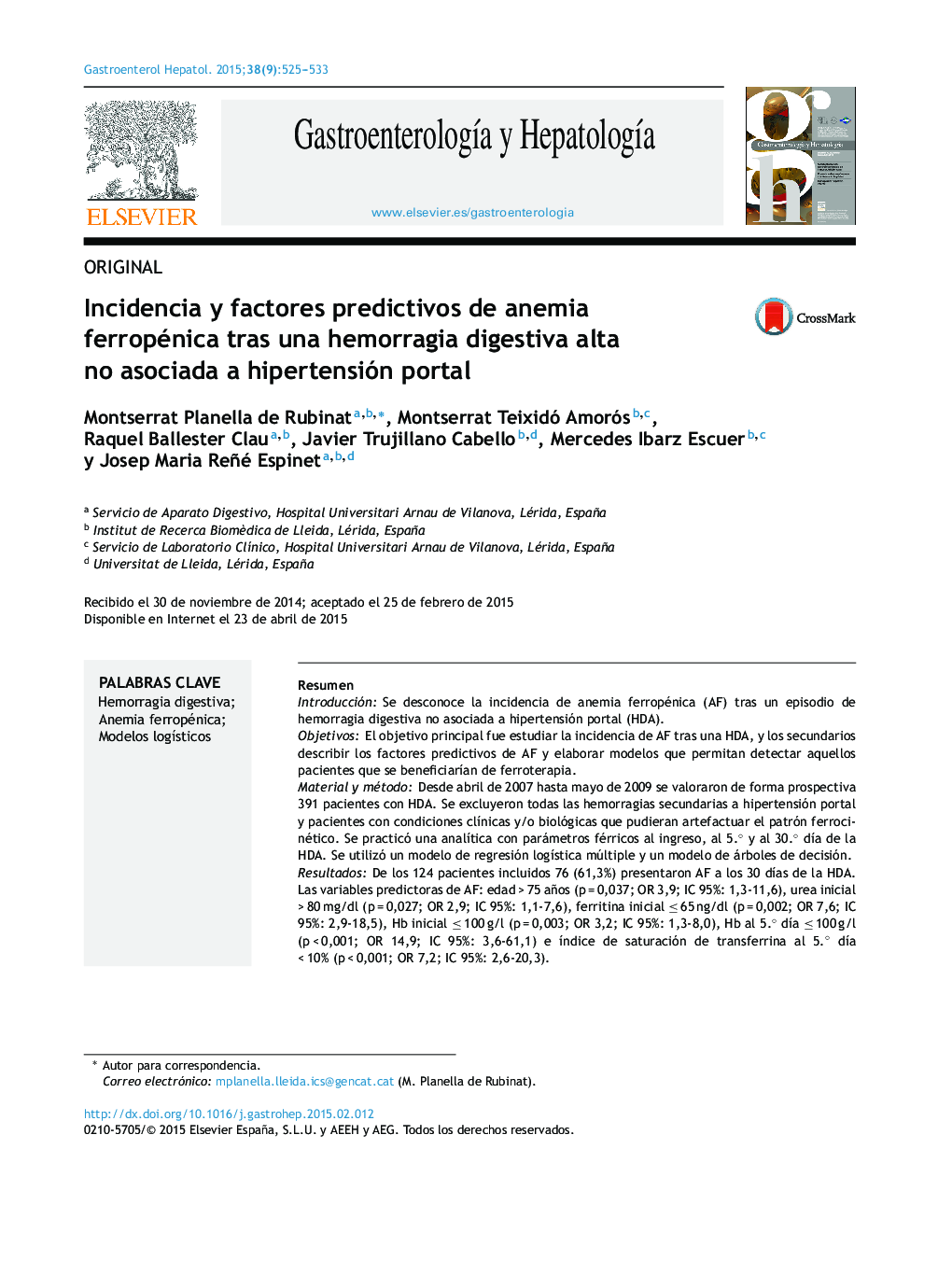| کد مقاله | کد نشریه | سال انتشار | مقاله انگلیسی | نسخه تمام متن |
|---|---|---|---|---|
| 3287714 | 1209456 | 2015 | 9 صفحه PDF | دانلود رایگان |

ResumenIntroducciónSe desconoce la incidencia de anemia ferropénica (AF) tras un episodio de hemorragia digestiva no asociada a hipertensión portal (HDA).ObjetivosEl objetivo principal fue estudiar la incidencia de AF tras una HDA, y los secundarios describir los factores predictivos de AF y elaborar modelos que permitan detectar aquellos pacientes que se beneficiarían de ferroterapia.Material y métodoDesde abril de 2007 hasta mayo de 2009 se valoraron de forma prospectiva 391 pacientes con HDA. Se excluyeron todas las hemorragias secundarias a hipertensión portal y pacientes con condiciones clínicas y/o biológicas que pudieran artefactuar el patrón ferrocinético. Se practicó una analítica con parámetros férricos al ingreso, al 5.° y al 30.° día de la HDA. Se utilizó un modelo de regresión logística múltiple y un modelo de árboles de decisión.ResultadosDe los 124 pacientes incluidos 76 (61,3%) presentaron AF a los 30 días de la HDA. Las variables predictoras de AF: edad > 75 años (p = 0,037; OR 3,9; IC 95%: 1,3-11,6), urea inicial > 80 mg/dl (p = 0,027; OR 2,9; IC 95%: 1,1-7,6), ferritina inicial ≤ 65 ng/dl (p = 0,002; OR 7,6; IC 95%: 2,9-18,5), Hb inicial ≤ 100 g/l (p = 0,003; OR 3,2; IC 95%: 1,3-8,0), Hb al 5.° día ≤ 100 g/l (p < 0,001; OR 14,9; IC 95%: 3,6-61,1) e índice de saturación de transferrina al 5.° día < 10% (p < 0,001; OR 7,2; IC 95%: 2,6-20,3).ConclusionesLa mayoría de pacientes con HDA presentan AF a los 30 días del episodio hemorrágico. La identificación de los factores predictivos de la misma permite establecer una indicación de ferroterapia tras la HDA.
IntroductionThere are few studies on iron deficiency anemia (IDA) after non-variceal acute upper gastrointestinal bleeding (UGIB) in patients without portal hypertension.ObjectivesTo define the incidence of IDA after UGIB, to characterize the predictive factors for IDA and to design algorithms that could help physicians identify those patients who could benefit from iron therapy.Material and methodWe registered 391 patients with UGIB between April 2007 and May 2009. Patients with portal hypertension and those with clinical or/and biological conditions that could affect the ferrokinetic pattern were excluded. Blood analyses were performed, including ferric parameters upon admission, on the 5 th day, and on the 30th day after the hemorrhage episode. We used a multiple logistic regression model and a classification and regression tree model.ResultsA total of 124 patients were included, of which 76 (61.3%) developed IDA 30 days after UGIB. The predictive variables were age > 75 years (P = .037; OR 3.9; 95% CI: 1.3-11.6), initial urea level > 80 mg/dL (P = .027; OR 2.9; 95% CI: 1.1-7.6), initial ferritin level ≤ 65 ng/dL (P = .002; OR 7.6; 95% CI: 2.9-18.5), initial hemoglobin level ≤ 100 g/L (P = .003; OR 3.2; 95% CI: 1.3-8.0), hemoglobin level on the 5 th day ≤ 100 g/L (P < .001; OR 14.9; 95% CI: 3.6-61.1) and the value of the transferrin saturation index on the 5 th day < 10% (p < 0.001; OR 7.2; 95% CI: 2.6-20.3).ConclusionsMost patients with UGIB developed IDA 30 days after the episode. Identification of the predictive factors for IDA may help to establish guidelines for the administration of iron therapy.
Journal: Gastroenterología y Hepatología - Volume 38, Issue 9, November 2015, Pages 525–533